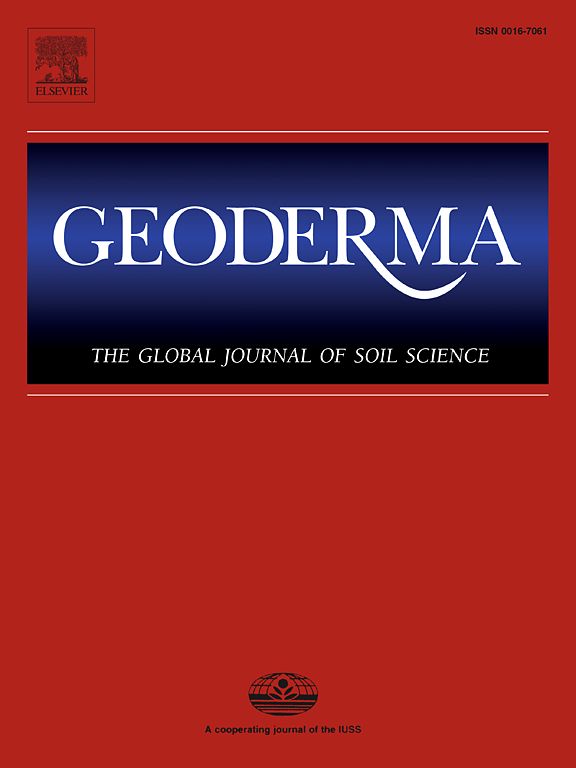Using satellite-derived attributes as proxies for soil carbon cycling to map carbon stocks in alpine grassland soils
IF 5.6
1区 农林科学
Q1 SOIL SCIENCE
引用次数: 0
Abstract
Alpine grassland ecosystems play a crucial role in the global carbon (C) balance by contributing to the soil organic carbon (SOC) pool; thus, quantifying SOC stocks in these ecosystems is essential for understanding potential gains or losses in soil C under the threat of climate change and anthropogenic activities. Remote sensing plays a vital role in estimating SOC stocks; however, identifying reliable remote sensing proxies to enhance SOC prediction remains a challenge. Information on soil C cycling proxies can reveal how the balance between C inputs and outputs affects SOC. Therefore, these proxies could be effective indicators of SOC variations. In this study, we explored the potential of satellite-derived attributes related to soil C cycling proxies for predicting SOC stocks. We derived remote sensing indices such as gross primary production, soil respiration, soil moisture, land surface temperature, radiation, and soil disturbance and assessed the relationships between these indices and SOC stocks via partial least squares structural equation modeling (PLS-SEM). We evaluated the effectiveness of these indices in predicting SOC stocks, we compared PLS-SEM and quantile regression forest (QRF) models across different variable combinations, including static, intra-annual, and inter-annual information. The PLS-SEM results demonstrated the suitability of the derived remote sensing indices and their interactions in reflecting processes related to soil C balance. The QRF models, using these indices, achieved promising prediction accuracies, with a coefficient of determination (R2) of 0.54 and a root mean square error (RMSE) of 0.79 kg m−2 at the topmost 10 cm of soil. However, the prediction performance generally decreased with increasing soil depth, up to 30 cm. The results also revealed that adding intra- and inter-annual information to remotely sensed proxies did not increase the prediction accuracy. Our study revealed that gross primary production, soil respiration, soil moisture, land surface temperature, radiation, and soil disturbance are effective proxies for representing factors influencing soil C balance and mapping SOC stocks in alpine grasslands.
利用卫星衍生属性作为土壤碳循环指标,绘制高寒草地土壤碳储量图
阿尔卑斯山草地生态系统在全球碳(C)平衡中发挥着至关重要的作用,为土壤有机碳(SOC)库做出了贡献;因此,量化这些生态系统中的 SOC 储量对于了解在气候变化和人为活动的威胁下土壤碳的潜在增减至关重要。遥感在估算 SOC 储量方面发挥着至关重要的作用;然而,确定可靠的遥感代用指标以加强 SOC 预测仍然是一项挑战。土壤碳循环代用指标的信息可以揭示碳输入和输出之间的平衡是如何影响 SOC 的。因此,这些代用指标可以成为 SOC 变化的有效指标。在本研究中,我们探讨了卫星获取的土壤碳循环代用指标相关属性在预测 SOC 储量方面的潜力。我们得出了总初级生产量、土壤呼吸、土壤水分、地表温度、辐射和土壤扰动等遥感指数,并通过偏最小二乘结构方程模型(PLS-SEM)评估了这些指数与 SOC 储量之间的关系。我们评估了这些指数在预测 SOC 储量方面的有效性,并比较了不同变量组合(包括静态、年内和年际信息)下的 PLS-SEM 模型和量子回归森林(QRF)模型。PLS-SEM 结果表明,得出的遥感指数及其相互作用适用于反映与土壤碳平衡相关的过程。使用这些指数的 QRF 模型取得了良好的预测精度,在土壤最上层 10 厘米处的决定系数 (R2) 为 0.54,均方根误差 (RMSE) 为 0.79 kg m-2。然而,随着土壤深度的增加,预测性能普遍下降,最高为 30 厘米。研究结果还表明,在遥感代用指标中添加年内和年际信息并不能提高预测精度。我们的研究表明,总初级生产量、土壤呼吸作用、土壤湿度、地表温度、辐射和土壤扰动是代表高寒草地土壤碳平衡影响因素和绘制 SOC 储量图的有效代用指标。
本文章由计算机程序翻译,如有差异,请以英文原文为准。
求助全文
约1分钟内获得全文
求助全文
来源期刊

Geoderma
农林科学-土壤科学
CiteScore
11.80
自引率
6.60%
发文量
597
审稿时长
58 days
期刊介绍:
Geoderma - the global journal of soil science - welcomes authors, readers and soil research from all parts of the world, encourages worldwide soil studies, and embraces all aspects of soil science and its associated pedagogy. The journal particularly welcomes interdisciplinary work focusing on dynamic soil processes and functions across space and time.
 求助内容:
求助内容: 应助结果提醒方式:
应助结果提醒方式:


